Reader Jennifer E.B. alerted us to the Dutch tradition of Zwarte Piet, “Black Pete.” Jennifer writes:
I grew up in a town that was overwhelmingly Dutch. Most people in town had Dutch anscestry (though not my family), there was a Dutch festival each spring, and before Christmas there was a Sinterklaas parade (Dutch Santa Claus). When we were there for Christmas this year both of my daughters received a chocolate in the shape of their initial in their stockings from my sister. I had let them have some of the chocolate several times before the background picture on the box caught my eye.
What Jennifer saw was what looked like a character in blackface (product found here):
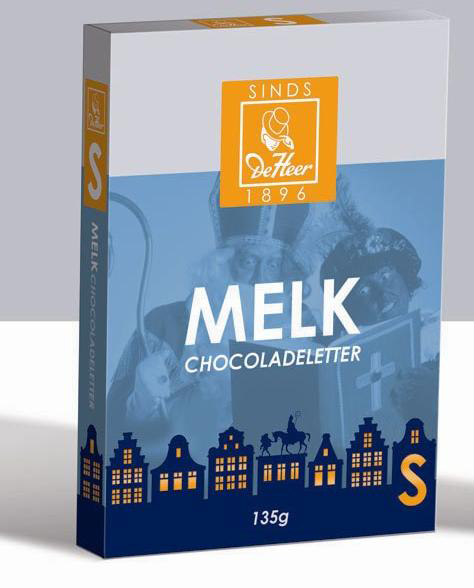
Jennifer did some digging and she discovered that Zwarte Piet is a traditional Christmas Sinterklaas character in the Netherlands.
Lulu Helder at the Museum of Racist Memorobilia explains:
The role is usually played by a white woman or man who wears black or brown grease paint on their faces (Saint Nicholas is always performed by a man). He or she wears large golden earrings, a curly wig and red lipstick. Right now they wear brown grease paint more often because “the blackness frightens children”.
Once the transformation is completed, a change in voice and behaviour usually follow. He or she will speak improper Dutch with a low voice and a Surinamese accent.
Below the jump are some pictures (not safe for work):
People dressed up as Sinterklaas and Zwarte Piet (from here, here, and here):
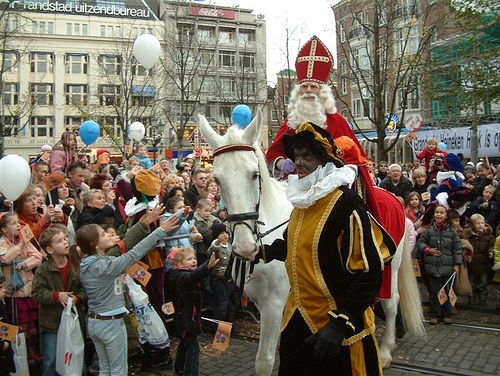
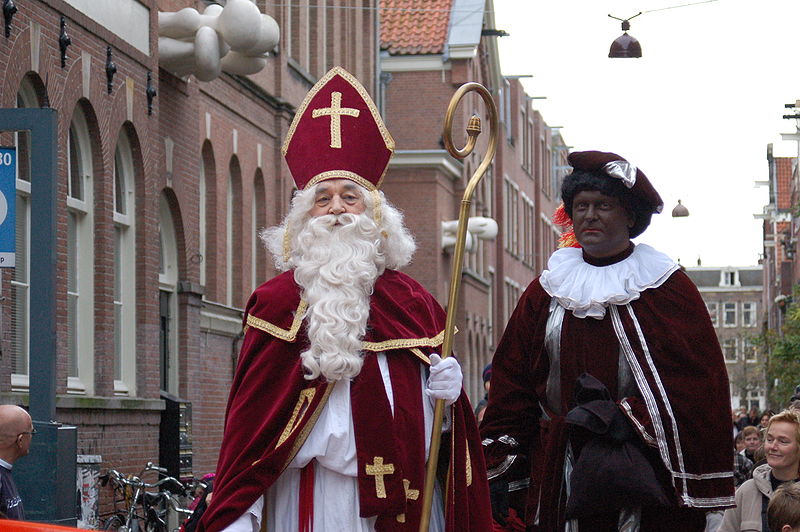
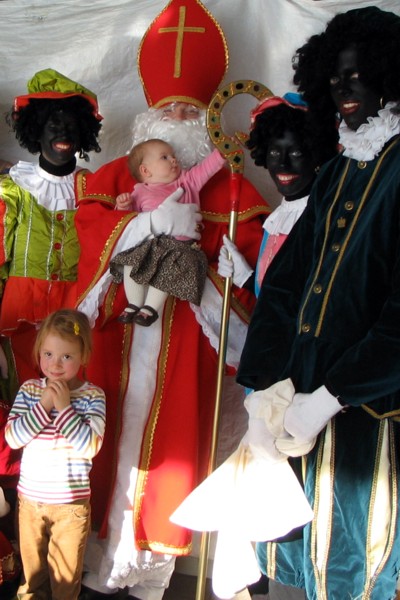
Here is a website where you can purchase Sinterklaas and Zwarte Piet costumes.
Some pictures of figurines and a book from Dutch Village:
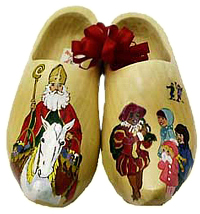
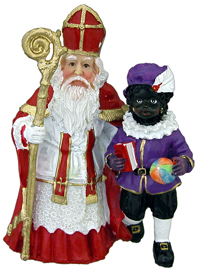
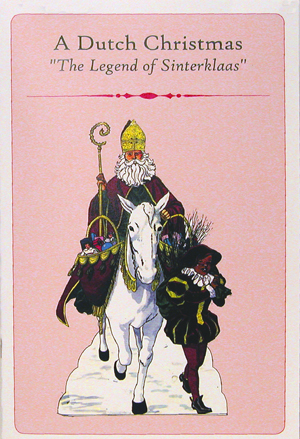
Jennifer even found some examples of representations of Black Pete on Cake Wrecks:
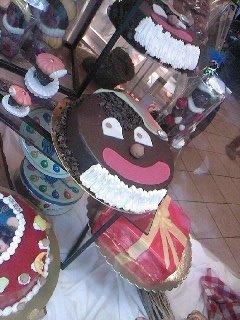
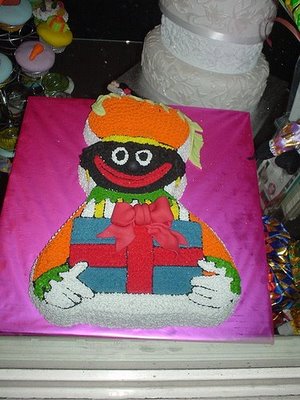
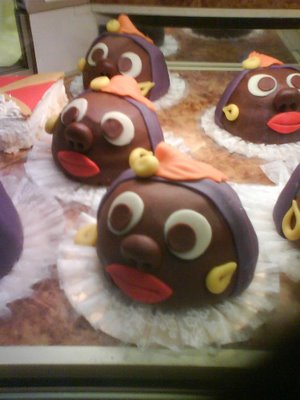
Helder offers this history of Zwarte Piet:
[Beginning in the 12th century] black slave-characters that accompanied Saint Nicholas originally symbolised the devil, a ‘joker’ who was submissive, frightening and disobedient at once. At this point there were no ‘racial’ references to people of African descent. Although the Mores were also associated with the devil, the blackness of the children did not refer to them but to the devil-figure. In other words; this color bias preceded the racial-bias. When Saint Nicholas re-appeared at the end of the 18th century after being banned, he returned alone, without Black Peter.
In the 19th century the black devil returns, this time re-invented as a servant of Moorish descent. He wears the costume of the child-slaves that work in Europe at that time, the pages. Carrying a large bag and his rod he threatens to take children that behaved bad. In an era of slavery and colonialism the racial ideas of that time were translated onto this figure.
Helder reports that the Zwarte Piet character is controversial in the Netherlands, but that the opposition is not strong enough to have made much of a dent in the representation.
UPDATE: Comments on this post are now closed.
Lisa Wade, PhD is an Associate Professor at Tulane University. She is the author of American Hookup, a book about college sexual culture; a textbook about gender; and a forthcoming introductory text: Terrible Magnificent Sociology. You can follow her on Twitter and Instagram.
Comments 47
Sean Jin — December 24, 2009
Do you think this has any relation to Krampus?
Emma — December 24, 2009
A young man performing 'Black Peter' was attacked recently in the Dutch city of Deventer:
http://afroeurope.blogspot.com/2009/12/black-peter-deblackfaced-netherlands.html
Anna — December 24, 2009
You quote Helder saying "this color bias preceded the racial-bias." I haven't really thought about it before but now I'm wondering how much this color-bias affected how Europeans perceived Africans, given their own cultural and religious (Christian; I don't know about Jewish) associations of the color black with evil and degradation?
I know it's been a struggle because European tradition has strongly negative cultural associations to the word 'black' - and calling African-Americans black seems to lead in to these associations. Is this valid at all? How do we untangle this?
Anneloes — December 24, 2009
Always interesting to read about Black Pete, being Dutch myself. Basically everything above is correct, although I have never in my life encountered a zwarte piet who spoke with a Surinamese or Antilles accent.
There have been continuous (yearly, basically) debates here about introducing 'colored petes', with orange, purple, green, etc. faces, to get rid of the racist stigma that has come attached to black pete. I myself, however, have never associated zwarte piet with actual black people, so to say. It was always very much a costume for me, at least since I didn't believe in Sinterklaas (Saint Nicholas) anymore. Before that they were 'just' his helpers, kind of in the same realm as Santa's elves. Someone you never saw except for the two weeks that Saint Nicholas was in the country.
Han — December 24, 2009
I also grew up in a Dutch town (everything Jennifer wrote is true of my town, but it's only 10,000, so the chances of us being from the same town is slim-- but I'm from south-central Iowa).
I don't know if this was just the influence of my parents, but Black Pete was just a guy who hung out with Sinterklaas and was his buddy. It was insignificant that he was black-- it wasn't until I became an adult that I realized there could possibly be any racial meaning to it. But it wasn't my ignorance that kept racial meaning out of it when I was a child-- for our family, there just wasn't any. Black Pete was just a guy; his skin color was only the basis of his nickname, not his societal position.
When the town celebrates Sinterklaas, the children (usually girls) chosen to play Black Pete are usually white, and they never black their faces. I think this helped enforce the idea that he's just Sinterklaas's friend and assistant.
Kat — December 24, 2009
I recently had a discussion with a Black (well, triracial) Dutch friend of mine. She was okay with the Zwarte Piet (I'm not), but objected to German (we both live in Germany) Negerkuesse/Mohrenkoepfe (chocolate sweets which used to be called "Negro's kisses" or "Moors' heads").
FVDE — December 24, 2009
Yeah, we have this in Belgium too and as a kid I always considered Zwarte Piet Sinterklaas' goofy friend & helper. I've never heard them speak with 'foreign' accents or seen any other racial connotations (the black faces were explained as a result of his exploits in chimneys and I never connected them to actual black people).
? — December 24, 2009
I do not think that this labeling evil entities in folklore as black has anything to do with race. Blackness commonly symbols evil and unpurity. All in all, the whole idea of interpreting tradition according to todays political correctness seems really fishy. This whole angle to this issue seems to come from people that have the USA´s social standards and ideas of how these things should be "correctly" portrayed based on the associations that are presented here. Isn't that terrible? Let us hope that these america-minded misguided political correctness maniacs never get to have their way to tampering with our tradition. And why is this judgemental cultural standard imposed on these traditions from outside of this culture, again? Not your culture, you do not have any say on it.
Eline — December 24, 2009
Yep, I agree with the Belgian and Dutch commenters (Belgian myself), Sinterklaas and Pete were portrayed as equal. There's even a programme on TV in which you can see that they're best friends. The racial tone of this is purely historical. Also, you might look into the fact that blackface is uhm, of American origin.
eric — December 24, 2009
I first learned about the Zwarte Piet from David Sedaris's story "6 to 8 Black Men". http://www.youtube.com/watch?v=sbJpRLhaSqs
Ryan — December 24, 2009
My chuckle in this whole thing is that your definition of "not safe for work" pictures is waaaaaaaaaaay different from mine.
KD — December 24, 2009
So some people have been saying that they didn't read this as racist when they were children, but I think it's worth pointing out that a lot of racism doesn't read as racist when you're that age. How many people that watched Disney films as a child thought, at that age, that the crows in Dumbo, or the apes in the Jungle Book, or the hyenas in the Lion King were racist? In fact, I was sure that Uncle Remus had an equal relationship with the white children he told stories to, because they looked like they were all having so much fun. And "wetback" was simply an innocent signifier of race to me, no more offensive than the word "white."
Being an American, I can't say much on the subject of Black Pete, but I thought that was worth mentioning.
Lynn — December 24, 2009
Another reader from Belgium here, and I'd have to agree with the previous Dutch/Belgian posters.
Zwarte Piet has never been evil for me or anyone that I know. I've never heard them speak with an accent or a different voice than the actual voice of the actors. And like a previous poster said, when I was a child I certainly didn't see them as a representation of coloured people, they were just Black Petes, like the US has Santa Claus. (I also never yelled "Hey Black Pete!" when I saw people of colour on the streets, that were two totally different things to me.)
Sinterklaas is still huge around these parts, especially in the Netherlands where he arrives in a city each year (supposedly coming from Spain) and it's a big nationalized TV event. All the kids are happy to see St-Niklaas and the different Black Petes because they bring gifts and candy. The kids call the Black Petes to give them drawings they made, shake their hand or take a picture with them.
And the blackface... That term is something we are not familiar with. It was only last year that I learned about it myself and what it means in the culture of the United States. Dressing up in what Americans would call blackface is not seen as offensive here, unless you are trying to be offensive (by, indeed, abusing racial stereotypes, makes offensive jokes, etc).
Lynn — December 24, 2009
It also might be worth to note that I have encountered very little racism towards black people in my life. I'm sure it still exists in small towns, but nowadays racism in Europe is almost always aimed at Muslims.
Kat — December 24, 2009
@ Lynn: That is such ignorant bull, I have no words... Where in Europe do you live???
tikvah4u2 — December 24, 2009
My sister from the Netherlands Antilles attended university in Holland (about 40 years ago) and remembers, being embarassed and shocked by the displays of Black Peter.
Kat — December 24, 2009
@ Martina: I would have preferred if you would have briefly apologized for falsely accusing me.
Something else: Generally, I don't believe that it is possible for White people to properly assess the prevalence of racism towards Black people- in any country.
notthemarimba — December 24, 2009
There's actually a Dutch imports store by my house that has people in blackface standing outside every winter... I always just drive by and feel awkward and wonder why it's not occurred to the owners that in Utah, that might not be appropriate.
Sue — December 25, 2009
Yeah, keep telling yourself that. :-)
This reminds me of a discussion I and another African American woman had with some French people about a French expression for a ghostwriter. It's essential the French equivalent of the "N word."
The French folk kept saying, Oh, it's a compliment. This person works hard ...
... like an "N word."
They could not grasp that the term was offensive.
When I saw the candy display for Black Pete, I couldn't but think, now if this were an Asian character, and I saw a row of yellow marzipan caricatured heads, what would I think?
erik smit — December 23, 2010
Okay, here's a few thoughts from Holland:
Lulu Helder's claims that "He or she will speak improper Dutch with a low voice and a Surinamese accent." are not true - unless she saw a Zwarte Piet who was actually Surinamese (they're an important minority, mainly in Amsterdam) of course. It is Sinterklaas, not Zwarte Piet, who speaks in a low voice.
What hasn't been mentioned yet is that of the two characters, Sinterklaas is generally strict and stern. Nothing like Santa Claus. Zwarte Piet is generally funny, friendly and approachable, and kids love him.
I find the 'not safe for work' comment very strange, by the way. But apparently the Americans have a similar character who does have racist connotations - this would explain why Americans often think the character of Zwarte Piet is racist. So in the end it all seems to come down to a misundertanding - our non-racist Zwarte Piet has similarities to an American character from the past who was racist.
In Holland we do have tremendous issues with racism, by the way. But this is generally directed against muslims (Turks and Moroccans to be precise: our two largest racial minorities are overwhelmingly muslim). We even have a racist party backing our government at the moment, and the hatred against muslims is an ongoing issue that is tearing up our country. That is where our true problems lie, not in the color of a friendly children's character's face.
erik smit
flickr.com/eti-eti
shorelines — December 26, 2010
I am dying to know why the comments were closed.
M. M. Amir ( a moslem) — December 3, 2011
A more accurate description of Sinterklaas and Zwarte Piet can be found in http://en.wikipedia.org/wiki/Sinterklaas.
Zwarte Piet was a slave, who was bought and liberated by Sinterklaas.
Dream Destination: Christmas in Europe - meganotravels | meganotravels — December 3, 2012
[...] via [...]